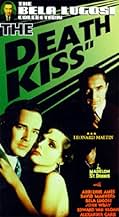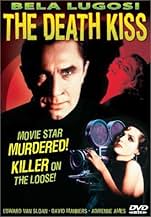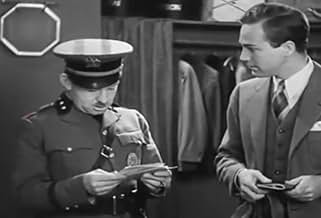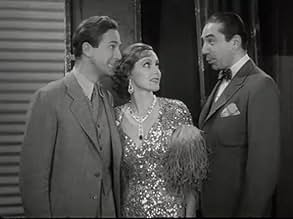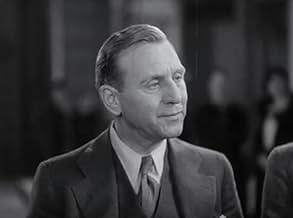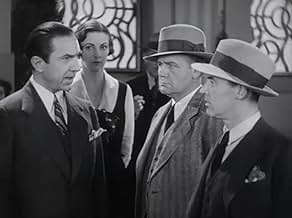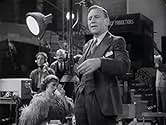CALIFICACIÓN DE IMDb
6.0/10
1.6 k
TU CALIFICACIÓN
Un asesinato durante el rodaje de una película desencadena la búsqueda de un asesino.Un asesinato durante el rodaje de una película desencadena la búsqueda de un asesino.Un asesinato durante el rodaje de una película desencadena la búsqueda de un asesino.
- Dirección
- Guionistas
- Elenco
Harold Waldridge
- Charlie
- (as Harold Waldrige)
King Baggot
- Al Payne
- (sin créditos)
Wilson Benge
- Café Henri Actor Doorman
- (sin créditos)
Phil Bloom
- Hood
- (sin créditos)
Eddie Boland
- Bill
- (sin créditos)
Morgan Brown
- Crew Member
- (sin créditos)
Opiniones destacadas
Despite its low-budget look, "The Death Kiss" is a solid mystery, and it does a good job of creating a believable movie studio atmosphere as the background to the main story. It's also interesting to see Bela Lugosi, Edward Van Sloan, and David Manners reunited in a setting so different from "Dracula". While some of its limitations are rather obvious, it's a pretty good effort for a low-budget feature from the early sound era.
The opening sequence might be the best part of the movie, as it cleverly sets up the mystery, introduces most of the characters, and illustrates the movie's themes. In the main part of the movie, it generally follows convention, with Manners as an eager amateur who is usually a step ahead of the police. The pace is also a little uneven at times, which was relatively common in the early 1930s, but there are always some interesting details and developments that keep it together.
Van Sloan, as a movie director, gets some pretty good opportunities. Lugosi is always a welcome addition to any suspense or mystery story, and he makes the most of a character who doesn't really get all that much to do. As the lead, Manners is likable, though often a bit bland. Adrienne Ames is adequate as the heroine, and the minor characters are given some occasional moments of their own.
The result is a decent mystery that keeps you guessing. It will probably be of interest mainly to those who are already fans of the era and genre, but with that in mind it's not bad.
The opening sequence might be the best part of the movie, as it cleverly sets up the mystery, introduces most of the characters, and illustrates the movie's themes. In the main part of the movie, it generally follows convention, with Manners as an eager amateur who is usually a step ahead of the police. The pace is also a little uneven at times, which was relatively common in the early 1930s, but there are always some interesting details and developments that keep it together.
Van Sloan, as a movie director, gets some pretty good opportunities. Lugosi is always a welcome addition to any suspense or mystery story, and he makes the most of a character who doesn't really get all that much to do. As the lead, Manners is likable, though often a bit bland. Adrienne Ames is adequate as the heroine, and the minor characters are given some occasional moments of their own.
The result is a decent mystery that keeps you guessing. It will probably be of interest mainly to those who are already fans of the era and genre, but with that in mind it's not bad.
Not bad little cheapie, an early talkie about a murder in a movie studio. Enough clues to go on, some good red herrings, and only a couple of holes in the plot. Of course, to film buffs, Lugosi is the main attraction, but his part is small and his accent distracts. Interesting peeks at working movie company in the 30s.
Here's another important early detective movie. It is important because it is early in the life of talkies (just two years after, really); it is a mystery (which was just being invented cinematically); and it is "folded."
That last means that it is a movie. And it is about a movie. All the characters except the hapless police detective are part of the movie within, which is also called "The Death Kiss." That designated detective is our usual surrogate: in the outer film trying to suss out the inner.
The murder in question is a murder in the movie within that is "real," meaning it is also in the outer movie. The real detective turns out to be the writer of the inner movie. I am not sure if this is the first appearance of this particular device. I would appreciate hearing if it is not. If it is, this film is of enormous importance. If not, it is still important, though for enjoyment purposes, well its pretty far down the list.
I'm tentatively making this a "worth watching," but if I confirm that it is the first talking with a movie with written by the same guy that writes the outer movie, I'll elevate it to a four.
Ted's Evaluation -- 3 of 3: Worth watching.
That last means that it is a movie. And it is about a movie. All the characters except the hapless police detective are part of the movie within, which is also called "The Death Kiss." That designated detective is our usual surrogate: in the outer film trying to suss out the inner.
The murder in question is a murder in the movie within that is "real," meaning it is also in the outer movie. The real detective turns out to be the writer of the inner movie. I am not sure if this is the first appearance of this particular device. I would appreciate hearing if it is not. If it is, this film is of enormous importance. If not, it is still important, though for enjoyment purposes, well its pretty far down the list.
I'm tentatively making this a "worth watching," but if I confirm that it is the first talking with a movie with written by the same guy that writes the outer movie, I'll elevate it to a four.
Ted's Evaluation -- 3 of 3: Worth watching.
So who fiddled with the props. Heart-throb actor Brent was only supposed to get shot with blanks. But now he lies on the sound stage floor, deader than the proverbial doornail.
As a whodunit, the movie's only moderately interesting. As a peek inside a filming crew, the movie's fascinating. But as a subtext of studio politics, the movie's a subtle insider glimpse.
To me, the film's highpoint comes when the studio head Grossmith stumbles for words for the press, only to be interrupted by his flowery pr man who dishes out the pr pablum in high-falutin' style. I'm wondering how much of that is aimed at the relatively uneducated likes of Louis B. Mayer at MGM or Jack Warner at Warner Bros. Then too, note how the real crime-solving sleuth is not an executive type, but a screenwriter (Manners) instead. Now how do you suppose that decision ended up in the script. Sometimes being a lowly screenwriter has its hidden perks.
Anyway, it's certainly different to catch Lugosi not making a meal out of somebody's neck. Still, I kept wanting to tell people not to stand too close. Then there' s the luscious Adrienne Ames (Marcia) who can go toe-to-toe with any Hollywood beauty of that day or this. Too bad she died so young. And, of course, there's Manners who started out as annoyingly smug when outsmarting the coppers. I'm glad he eased eventually into someone more likable.
All in all, the movie's worth catching up with for its insider look at movie-making, 1930's style.
As a whodunit, the movie's only moderately interesting. As a peek inside a filming crew, the movie's fascinating. But as a subtext of studio politics, the movie's a subtle insider glimpse.
To me, the film's highpoint comes when the studio head Grossmith stumbles for words for the press, only to be interrupted by his flowery pr man who dishes out the pr pablum in high-falutin' style. I'm wondering how much of that is aimed at the relatively uneducated likes of Louis B. Mayer at MGM or Jack Warner at Warner Bros. Then too, note how the real crime-solving sleuth is not an executive type, but a screenwriter (Manners) instead. Now how do you suppose that decision ended up in the script. Sometimes being a lowly screenwriter has its hidden perks.
Anyway, it's certainly different to catch Lugosi not making a meal out of somebody's neck. Still, I kept wanting to tell people not to stand too close. Then there' s the luscious Adrienne Ames (Marcia) who can go toe-to-toe with any Hollywood beauty of that day or this. Too bad she died so young. And, of course, there's Manners who started out as annoyingly smug when outsmarting the coppers. I'm glad he eased eventually into someone more likable.
All in all, the movie's worth catching up with for its insider look at movie-making, 1930's style.
"The Death Kiss" (Tiffany, 1932), directed by Edwin L. Marin, might have been a very interesting vampire movie, but instead, the director fools his movie audience by revealing, from the very first few minutes into the story, to be an inside study at the behind the scenes look in movie making, combining murder mystery with comedy, but not all too successfully. The main interest is not in the "who done it" plot itself, but on its three major actors, David Manners, Bela Lugosi and Edward Van Sloan, better known today for their performances in director Tod Browning's thriller, "Dracula" (Universal, 1931), with Lugosi as the title-role character-star with Manners and Van Sloan in support. In this reunion, Manners takes center stage over Lugosi and Van Sloan in smaller roles. Although Lugosi is not in every scene, he does make his presence felt throughout its 70 minute venture.
The fade-in of "The Death Kiss" opens outside a ritzy nightspot where a woman is to mark a certain man for death by kissing him in the lobby of a fashionable apartment building. Moments later, gun shots are fired by passing mobsters, killing the man in question, followed by a crowd gathering. Then the camera pulls away, revealing the sound stage and focusing on the behind-the-scenes crew consisting of a script girl, cameramen, assistant director, and director (Edward Van Sloan) who wants to have a retake, feeling that the death scene did not look realistic enough. Hollywood realism sets in when moments later, it is revealed that the actor, Myles Brent (Edmund Burns), the doomed character in the production of THE DEATH KISS, has actually been shot and killed. Top-billed David Manners as Franklin Drew, a mystery writer, steps into the picture trying to solve the murder in order to prevent the leading lady, Marcia Lane (Adrienne Ames), whom he has become interested, from becoming the prime suspect. Detectives are called in, and after a few more murders at the movie studio, Drew draws to his own conclusions as the detectives (and the viewers) become baffled before the killer is revealed.
The supporting cast includes Bela Lugosi as Joseph Steiner, president of the Tonart movie studio; Edward Van Sloan as Tom Avery, the film director; John Wray as Detective Sheehan; Vince Barnett as Officer Gulliver, affectionately called "a Keystone Cop" due to his buffoonery; Alexander Carr as the accented Leon A. Grossmith; with Barbara Bedford as the script girl; and Harold Waldridge as Charlie, the bellboy, among others.
A rediscovered "poverty row" mystery that enjoyed frequent revivals during the early years of cable television in the 1980s, "The Death Kiss" recently has been restored with hand-tinted red color sequences used in parts with studio lights and gun shots, but otherwise a routinely old-fashioned mystery from the short-lived Tiffany Studios and not by Universal. A public domain title, "The Death Kiss" has been available on video cassette by numerous distributors in the 1980s. Currently, the best clear and sounding print can be found on both restored video copies and/or from Turner Classic Movies where it airs in October in honor of Halloween.
Although the storyline can be confusing at times, with director Edwin L. Marin continuing to play tricks on his movie audience (as with his opening scene and movie title) by keeping them guessing, with the "comedy relief" turning out not to be all that amusing, "The Death Kiss" in turn is a likable little time filler from the bygone days of Hollywood.(*1/2)
The fade-in of "The Death Kiss" opens outside a ritzy nightspot where a woman is to mark a certain man for death by kissing him in the lobby of a fashionable apartment building. Moments later, gun shots are fired by passing mobsters, killing the man in question, followed by a crowd gathering. Then the camera pulls away, revealing the sound stage and focusing on the behind-the-scenes crew consisting of a script girl, cameramen, assistant director, and director (Edward Van Sloan) who wants to have a retake, feeling that the death scene did not look realistic enough. Hollywood realism sets in when moments later, it is revealed that the actor, Myles Brent (Edmund Burns), the doomed character in the production of THE DEATH KISS, has actually been shot and killed. Top-billed David Manners as Franklin Drew, a mystery writer, steps into the picture trying to solve the murder in order to prevent the leading lady, Marcia Lane (Adrienne Ames), whom he has become interested, from becoming the prime suspect. Detectives are called in, and after a few more murders at the movie studio, Drew draws to his own conclusions as the detectives (and the viewers) become baffled before the killer is revealed.
The supporting cast includes Bela Lugosi as Joseph Steiner, president of the Tonart movie studio; Edward Van Sloan as Tom Avery, the film director; John Wray as Detective Sheehan; Vince Barnett as Officer Gulliver, affectionately called "a Keystone Cop" due to his buffoonery; Alexander Carr as the accented Leon A. Grossmith; with Barbara Bedford as the script girl; and Harold Waldridge as Charlie, the bellboy, among others.
A rediscovered "poverty row" mystery that enjoyed frequent revivals during the early years of cable television in the 1980s, "The Death Kiss" recently has been restored with hand-tinted red color sequences used in parts with studio lights and gun shots, but otherwise a routinely old-fashioned mystery from the short-lived Tiffany Studios and not by Universal. A public domain title, "The Death Kiss" has been available on video cassette by numerous distributors in the 1980s. Currently, the best clear and sounding print can be found on both restored video copies and/or from Turner Classic Movies where it airs in October in honor of Halloween.
Although the storyline can be confusing at times, with director Edwin L. Marin continuing to play tricks on his movie audience (as with his opening scene and movie title) by keeping them guessing, with the "comedy relief" turning out not to be all that amusing, "The Death Kiss" in turn is a likable little time filler from the bygone days of Hollywood.(*1/2)
¿Sabías que…?
- TriviaKino Lorber films has released a Blu-Ray version of the film from an existing 35 mm print with missing scenes and the color hand tinted segments restored.
- ErroresAbout 12 minutes into the movie Franklyn Drew digs a bullet out of the wall and identifies it as a ".38 caliber center fire." It is impossible to tell from the bullet alone whether it was fired from a center fire or rim fire cartridge. Such a claim could lead to confusion in identifying the gun that fired the bullet.
- Citas
Officer Gulliver: Mr. Drew, I've been thinking.
Franklyn Drew: No!
Officer Gulliver: Yeah. The first thing I ask myself when I investigates a murder is 'who done it'.
Franklyn Drew: Well that sounds logical.
Officer Gulliver: And the next thing I ask myself is 'who could do it.'
Franklyn Drew: And then?
Officer Gulliver: Then I ask myself again 'who wanted to do it.'
Franklyn Drew: And how do you answer yourself?
Officer Gulliver: Well... I ain't come to that yet.
- ConexionesFeatured in Lugosi: Hollywood's Dracula (1997)
Selecciones populares
Inicia sesión para calificar y agrega a la lista de videos para obtener recomendaciones personalizadas
- How long is The Death Kiss?Con tecnología de Alexa
Detalles
- Tiempo de ejecución
- 1h 15min(75 min)
- Color
- Relación de aspecto
- 1.37 : 1
Contribuir a esta página
Sugiere una edición o agrega el contenido que falta

